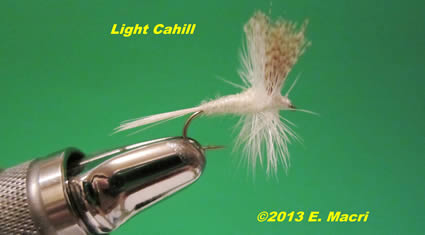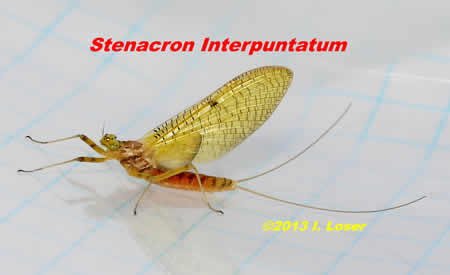The Light Cahill Mayflies: Stenonema, Maccaffertium, and Stenacron:
Summer Hatches
by
The Black Ghost

©2013 E. Macri
The Light Cahill maylfies were favorite hatches of my fishing buddies that I
grew up with in Western Pennsylvania. In the summer evenings we would wait for theses hatches
on Slippery Rock and Neshannock Creeks. Ray, Buddy, Glen, Bill Al, and Stan would take me
and my fishing friend Ricky to the streams before we could drive. Once we got our driver's license we
would meet them on the stream at our favorite sites. The fishing didn't always start well.
Sometimes the waters were too warm and the damn flies did not come off til rather late when the stream cooled
down. It didn't matter because school was out and we fished on into the night catching trout into the
darkness.
I learned a lot from those guys and the lessons stick with you. Those were wonderful days
learning
the craft of fly fishing and I pity the fly anglers who just jump into this
art without such beginnings. The classification of these mayflies has changed numerous times since then
but for the most part the techniques and methods haven't changed much. The Cahills and namely the Light
Cahills have been reclassified. But for our purposes the Light Cahills consist of a number of species from
the genera Maccaffertium, Stenacron and Stenonema. The adults vary in color from light
cream to orangish cream and vary in size from 12 to 16. The original species considered the
prototypical Light Cahill was Stenonema canadense which has been reclassified as Stenacron
interpuntatum. One species, Stenonema femoratum is still classified in the genus
Stenonema. All other relates species have been reclassified as Maccaffertium. The famed
Stenonema ithaca is now classified as Maccaffertium ithaca. This group now includes other minor
and related Cahill members such as Maccaffertium medipunctatum, pulchellum, and modestum.
Distribution and Habitat
For the most part these mayflies are found in the East and Midwest. The nymphs inhabit a
variety of water types from medium speed flows to faster stretches. Some species have specific requirements such as
Stenonema femoratum nymphs which seem to be found in slower stretches than other Light Cahill nymphs.
Light Cahills inhabit both freestone and limestone streams including parts of the Letort, Falling Spring Run.
There are some pretty heavy hatches on the Yellow Breeches in both the open water and fly area.
Emergence of Light Cahills
The Cahills are an evening hatch on most streams. However, on some streams they will come off in
the late afternoon. On streams that have more than one species of Cahill you may have many sizes and color
variation on the water at the same time. Some streams the hatches are sparse; on others there are good
populatons that hatch all evening. On some waters these mayflies will hatch sporadically every evening for all of
June and July. Other streams the flies may start as early as Mid May and go into September.
Spinner Returns
The imago or spinner of these flies will sometimes be returning while duns (subimagoes) are still
popping. This may complicate matters if the fly angler is not accustomed to observing "spinner rise"
patterns. In most instances the spinner rise for these flies is a quiet almost "dish like" swirl compared to
the taking of the duns. Some fly anglers never see Light Cahill spinner returns because on many streams they
are late in the night or early morning hours.
Light Cahill Nymphs
The nymphs are called flatheads or clingers. They are found in a variety of water types
depending upon species with most of them inhabitating medium to medium fast stretches. Contrary to what has
been written that the nymph patterns are no good until near hatching ---don't believe it. A small
flatish type brown to tan nymph in sizes 12-16 will catch fish all summer in many streams. Some species will
migrate towards the slower moving water prior to hatches which can often cause trout to line up in certain sections
of a stream or riffle.

Look carefully at the pattern below and tie nymphs to represent the flies in your stream.
Emergers are not that great for these flies. I have found over the years however, on some streams
and this is extremely variable the old Cahill wet fly patterns seem to work very well.

Light Cahill Duns
The duns vary in size from 12 to 16. The often get smaller as the season progresses.
The color variation of the different species is from creamy white to creamy orange brown to almost a cream orange
sherbert color. This color variation is influenced by the water chemistry of the steam. I've always
thought that standard dry fly patterns worked well. You can use a few small no hackles on more selective trout but
I have found that smaller standard patterns outfish the no hackle versions most of the time.
The duns can emerger sproradically thoughout the afternoon or evening or can come off in a pretty
well defined hatch depending upon stream populations. Floating nymphs will sometimes work well but I have
never found an emerger pattern to be much better than standard nymphs. However, a soft hackle cream in size
14 fished in the film can be deadly some days. On some streams the duns will ride the water for a long time giving
the trout ample opportunity for the take. Usually if the fish are moving around taking flies..they are taking
duns. If the trout are stationary with dish like swirls they are taking spinners.

Light Cahill Spinners
If you are luckey enough to fish the spinner fall I prefer standard polywing with fur of synthetic
bodies because you can see them a little better in the evening. Henwing spinners and even deer hair spinners
work well too depending upon lighting conditions. These are simple fly patterns that work fairly well. I
always thought that the trout were more concerned with size than any great variation in color on these flies. Tie a
variety of body color from tannish white to brownish cream and yellow brownish cream. Once again these
imagoes may return in the evening but with changing climate conditions you will also find many in the early morning
hours. Sizes from 12 to 16 depending upon the species emerging.

Final Thoughts on the Light Cahill
The Light Cahill hatches are always a nice hatch to fish. They usually come off during the
summer evenings and the fish are not that selective if you fish without spooking them. You can meet your
friends at the stream and talk, have a beer, a good cigar and fish together. You fish into the night, with
the sounds of the stream and the rising trout. What else could you ask for in this sorry world..this is what
life is all about! To my old friends in Western Pennsylvania both alive and dead I think of you often
especially when I see the Light Cahills.
| 




